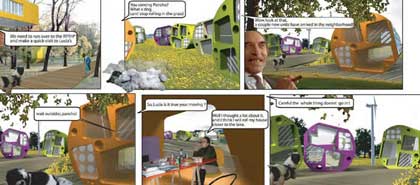elasticity is a urban infrastructure designed to support flexible living systems. Competing and interrelated city rhythms keep the architectural urban infrastructure in transformation and movement.
The housing systems:
– TH, the Tree House, a variable height re-combinative clustered home unit that is suspended above the park landscape. It can be arranged to house single families or serve as mini-hotels or residential dormitories.

– RRPH, Recycled Rolling Plastic House, is a prefabricated home unit for single users that can be assembled in series and rolled over. It has three sides, and three different living arrangements according to which side is placed at bottom.
Residents will occupy houses designed to last between 3 to 12 years (calculated on average stays in the local area). After that, the homes are dismantled and materials recycled back into the system. Recent arrivals will live in newly constructed homes, thus permitting more customized accommodations, adaptation to different cultural background, lifestyle and to technological improvements.
Hotel and hostel structures will add pre-fabricated units or subtract them according to seasonal demands.
The Main Ramblas Road can be transformed from heavy to light vehicular traffic to all pedestrian corridor, depending on peak and off peak shopping uses and traffic demands. This modification of the traffic corridor is accomplished by the advancing and retreating of the Flexible Commerce Center, the commercial establishments, stores and stalls that move up to form narrow pedestrian walking areas to increase pedestrian congestion and then recede when shopping traffic hours are minimal to allow for through traffic.
On weekends, portions of the FCC, parking areas, rooftops and street spaces are turned over to recreation uses. Gardens set aside for year round use will feature seasonal plantings and offer areas of personal green vegetable gardens.
A proposal by Avatar-Architettura.
Via Arch’IT Corriere della Sera (casamica).
